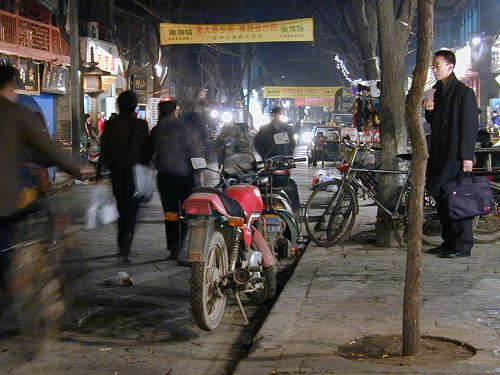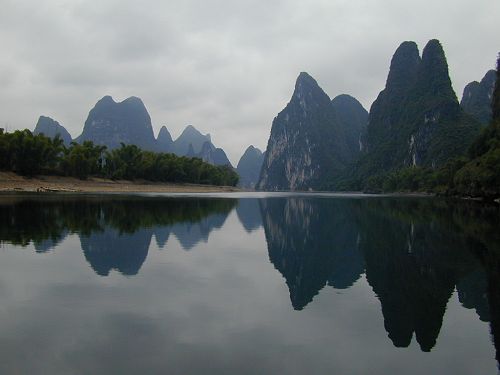Post Twelve - Xian and Guilin
 Chinese Trains Chinese TrainsThe trains in China are pretty good. With the exception of the printed schedule (which nobody who we showed it to could figure out), the train system is efficient, fairly clean, well used, and well maintained. This photo shows the interior of a second class sleeping cabin. This is known as a 'hard sleeper' (classes, of course, don't exist in communist China). There are six beds per compartment and the compartments don't have doors. People generally sit at little tables in the aisles, or on the bottom bunk. The top bunk can get quite cold in summer and hot in winter since it is right next to the AC/heater. The beds get cheaper the higher you go. Eventually, we learned to spend the extra money for the bottom bunk. It's much easier to get in and out of and you won't sweat in the heat. |
 Chinese Hotels Chinese HotelsThe hotels we stayed at in China are some of the best inexpensive accommodation I saw between Europe and Singapore. They're clean, large, have their own bathrooms, and include plenty of amenities like TV's and hot water brought to your room so you can make coffee, tea or instant noodles. Best of all, they are very affordable (about $20 per night for the room pictured). As tourists, you are only allowed to stay at 'tourist' hotels. There are plenty of other places people stay for only a few dollars per night but they are officially only for Chinese nationals. |
 Terracotta Warriors Terracotta WarriorsFrom Tai Shan we took the overnight train to Xian to see the famous terracotta warriors. After fueling up on steamed dumplings we took a bus 30 km outside of town to see the figures. The terracotta men, horses, and chariots were impressive but the buildings and museums built to house them were almost more impressive. The complex with the warriors had buildings and squares paved in marble and there were uniformed guards everywhere. The warriors themselves were amazing. There are over 6,000 of the life-sized figures buried in battle formation protecting the tomb of China's first emperor Shihuangdi. Shihuangdi ruled from 221-210 BC and was responsible for building most of the great wall. Amazingly, each of the figures has a different face so they are all unique. |
 Xian XianXian itself is quite an interesting town. In our book we read about an area with plenty of street vendors selling food. Intrigued, we wandered through the city, eventually getting lost and finding ourselves in a fairly ratty section of town. We persevered and found the area we were looking for. We had a great meal and outside I took a few photos. This is what I had expected all of China to look like. |
 Yangshuo YangshuoFrom Xian it was a night train south to Guilin where we went to see the famous karst formations. The town where we based ourselves, Yangshuo, was a cool little place. Its main street was the tourist drag, almost like a little Khao San road in China. We got into town, found a hotel, and booked a boat trip through the karst for the next day. That evening we had pizza and beer in one of the many tourist restaurants. |
 The Chinese The ChineseThe people we met in China were uniformly polite but also very inquisitive about who we were, where we had been in China, if we were married, etc. Riding the train was like a cultural exchange. People would crowd around to have a polite look, then someone who knew English would ask where we were from. Once the ice was broken, people spoke out questions and our new interpreter would ask us in English then translate our answers for the rest of the group. After an hour or so, most of the people would wander off and eventually we would be left with just our fellow compartment-mates. We met the two women in the photo in Yangshuo. They told us that Yangshuo has a reputation in China as being a place where a lot of western backpackers go. So much that it has become a stop on the river tours so the Chinese can buy souvenirs and see the exotic westerners. |
 Fishermen FishermenThese men use diving birds to catch fish for them. The birds have a ring around their neck that keeps them from swallowing the fish. Occasionally the fishermen take off the ring and feed their helpers. How they train the birds in the first place I'll never know. This was the view as we started our journey down the river. |
 Karst Landscape Karst LandscapeThe river cruise I went on will be etched in my memory for some time. The light was muted in the early morning when we set out. I saw the fishermen with their diving birds. I saw huge river boats from Guilin filled with Chinese tourists, cameras in hand, excited to spot a westerner in the wild. And coming back into Yangshuo, I saw this perfect view of the river. |
Next Up: Overland to Bangkok
Copyright 2002
Scott & Karen Semyan